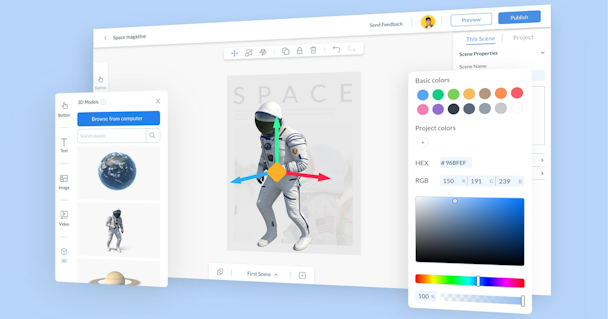The no-code revolution: how marketers can leverage AR tools in the metaverse
With technological innovation moving at warp speed and the merging of our digital and physical lives, it's vital that those advances are matched with tools to make them accessible to all. Zappar's marketing manager Grace Vassallo explores how marketers can use augmented reality (AR) tools for successful integration in the metaverse.

Zappar on the tools and skillsets that marketers need to invest in to keep up with the changing needs of the world. / Image via Zappar
The next phase of computing seems to be upon us, yet as the hype around building the metaverse ramps up, there's a real emerging need to ensure the democratization of these spaces.
It's estimated that 99.7% of the global population have no coding skills. If the barriers to entry are set so high as to only allow those with these advanced skills (and companies with extensive resources) to contribute to its creation, the metaverse then becoming a collection of walled gardens rather than an 'embodied Internet' which will benefit all.
With augmented reality (AR) quickly pulling ahead of virtual reality (VR) and evolving into the human digital interface through which most of us will engage with the metaverse on a daily basis, it's great to see the broader trend of the 'no-code revolution' beginning to offer the public and marketers exciting opportunities to create and influence this new world.
Until now, more advanced AR marketing campaigns have largely remained the purview of developers proficient in coding and companies able to develop specialist AR software development kits (SDKs). Yet just as tools like WordPress, Wix, and Squarespace have democratized web 2.0 development, there's now a multitude of affordable no-code AR tools that promise to open up AR creation to the masses.
Putting AR in the hands of every marketer
We've seen the popularity of AR face filters and world effects explode across social media, introducing people to the capabilities and joy of AR. And ever-more-powerful smartphones enable us to engage with AR content anywhere; whether during our commute, in stores, or online.
The benefits of AR to omnichannel campaigns are well documented. No-code AR content creation offers a cheaper, faster, and easier way for marketers to produce immersive, dynamic, and engaging campaigns, taking AR out of the innovation department and empowering brands to drive real business value.
More importantly, marketers on a modest budget can use no-code tools. In a couple of days, marketers can get up and running with tools like Adobe Aero or ZapWorks Designer that are well supported with documentation, have a shallow learning curve and can cost only a few hundred dollars, and begin designing and building AR campaigns without the costs associated with hiring a team of highly skilled developers.
This ease of use and affordability also ensures that AR can be a consistent part of any company’s marketing mix, providing simple design tools and rapid prototyping for complex omnichannel campaigns, a no-brainer as we all transition into the metaverse.
Incorporating AR into the marketing mix
With no-code tools at your disposal, AR can be baked into the marketing plan from the very start, forming the glue that holds the different strands of an impactful omnichannel strategy together, truly augmenting traditional billboard, print, and packaging campaigns.
Whether it’s AR triggered via a QR code on traditional print materials such as flyers, magazine ads, signage, or incorporated into display ads via a deep-link, AR has the power to bring passive marketing channels to life. It can provide interactive 3D visualization of products or brand mascots; transition users into mini-games or interactive AR experiences featuring music and animation; provide more product information; and even link users through to online channels, social media platforms or direct point-of-sale.
With the introduction of WebAR, it's now even easier for you to augment your marketing efforts by delivering extraordinary experiences to the web browser on every smartphone. It’s this accessibility, both from the end-user and creators' perspective that makes AR such a compelling proposition for marketers today.
In a world where smartphone usage is at an all-time high, and the way we interact with the world is constantly evolving, now's the time for marketers to invest in the tools and skill sets that will put them ahead of the pack.
Content by The Drum Network member:

Zappar
Zappar is the world’s leading augmented reality platform and creative studio for mobile and web apps. Since 2011, Zappar’s mission has been to democratise AR...
Find out more
